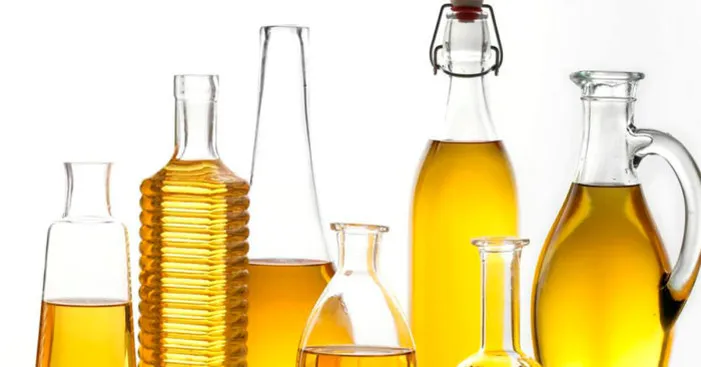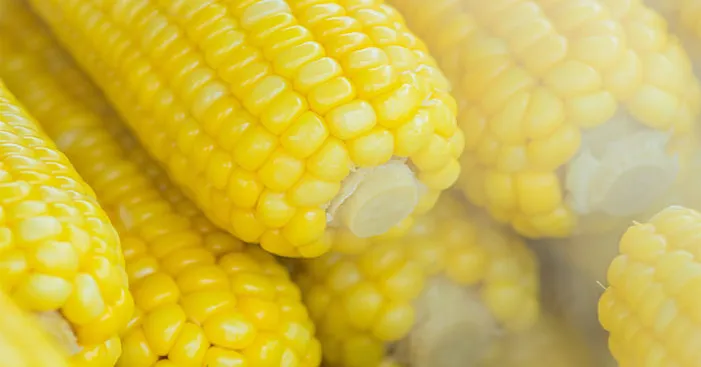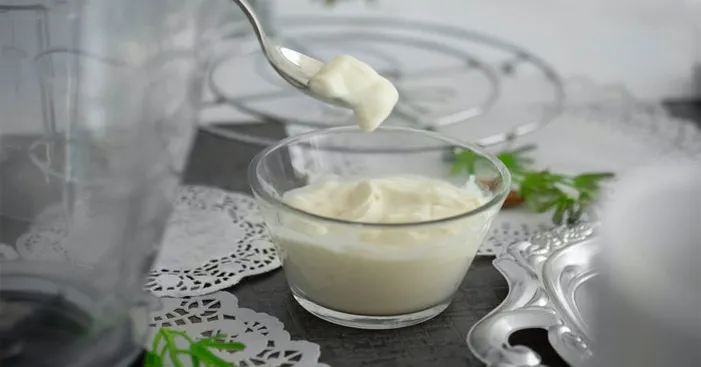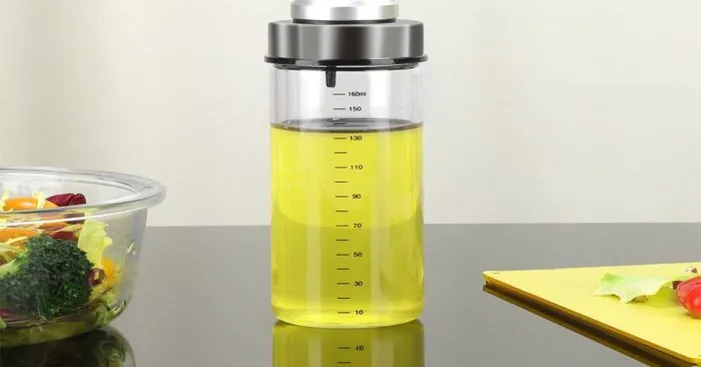Table of Contents

Are you looking for a versatile and healthy cooking oil? If so, corn oil may be the perfect choice!
Corn oil contains a variety of beneficial properties that make it a popular choice for cooking.
From its ability to reduce cholesterol levels to its potential anti–inflammatory properties, corn oil is an interesting and nutritious choice for a variety of dishes.
Corn oil is one of the most consumed vegetable oils worldwide and it’s the 3rd most used vegetable oil in the United States.
Despite the many health virtues of corn oil, the products sold in the US have already lost most of their nutrients.
Because of that, as consumers, we need to step up our game and know how to choose the best quality corn oil.
In this blog post, we‘ll explore the benefits and side effects of corn oil, how to buy it and use it in cooking, with tips on how store it!
What is corn oil:

Corn oil is extracted from corn seeds which represent one of the most famous crops worldwide.
Being almost always available in the market, this oil is one of the cheapest vegetable oils which explains its popularity.
The extraction of this oil undergoes many processes like extrusion, steam distillation, and refining.
With all that processing, this oil gains a high smoking point which makes it suitable for high-temperature cooking.
Nonetheless, we should know that the more industrialized the oil is the fewer nutrients it contains.
Therefore, if you want to benefit from all the nutrients in corn oil you need to get the cold-pressed varieties AKA organic.
Indeed, this oil comes nowhere near the benefits of almond oil or mostly olive oil, but organic corn oil has good properties as well.
In fact, you can’t cook using cold-pressed corn oil because it has a lower smoking point as it still contains beneficial polyunsaturated fats.
Corn oil vs other vegetable oils:

There are many vegetable oils that we could use in a similar way to corn oil so here’s the difference:
Rapeseed oil (canola oil):
As the name reveals “Rapeseed oil” comes from rapeseed flowers and is also known as “canola oil”.
This oil is extracted from the seeds in the same way corn oil is extracted using a heat process or cold pressure.
In the market, you can find extra-refined rapeseed oil suitable for frying and cold-pressed organic rapeseed oil.
Organic canola oil contains fatty acids mostly in the form of oleic acids and linoleic acids.
Rapeseed oil fatty acids are 65% oleic acids and 15% linoleic acids which is completely the opposite of corn oil.
Also, the flavor of this canola oil is less pronounced than corn oil which makes it blend better with other ingredients.
Rice oil:
This oil is made from rice bran, which is the pieces of husk that remain after milling the rice seeds.
Even though rice oil is not common in the United States, you can find it in Asian markets either organic or refined.
Thanks to the many benefits of rice husk, this vegetable oil is particularly rich in vitamin E with more than 30% of the daily needs in 1 tbsp.
In addition, rice oil fatty acids are in the form of palmitic acids (22%), linoleic acid (34%), and oleic acid (38%).
This oil can be a healthier choice than corn oil as it contains vitamin K, and vitamin E and has a rich unsaturated fatty acids profile.
Alongside sesame oil, rice oil is perfect for most Japanese dishes as the flavor combines well with most dishes in this cuisine.
Soybean oil:
Just like the name suggests, this oil is made from soybeans and is second only to palm oil in the list of the most produced vegetable oils worldwide.
Similarly to corn oil, you can find refined soybean oil and organic soybean oil in the market.
It is often used to make mayonnaise or margarine and also to make delicious salad dressings.
Soybean oil comes in a very light yellow (almost transparent),
With corn oil containing no vitamin K, soybean oil is particularly rich in this vitamin with more than 20% of the daily need per 1 tbsp.
Nonetheless, unlike corn oil, soybean oil may contain many allergens and additives especially because it is a very profitable oil to sell.
Corn oil nutritional values and health benefits:

Nutritional values:
Corn oil composition differs depending on the part which the oil is extracted from.
For instance, the oil extracted from the germs has the most linoleic acid content while having the least amount of saturated fats.
Also, the oil composition differs depending on the degree of maturity of the corn seed and the nature of the seed (hybrid or natural).
The fat profile of corn oil accounts for 85% of unsaturated fatty acids in the form of linoleic and oleic acids.
The remaining 15% are basically saturated fatty acids which the body also needs but in small quantities.
Generally, commercial organic corn oil’s unsaturated fatty acids are 60% linoleic acid and 25% oleic acid.
In addition, there are few traces of other fatty acids including arachidic acid( also found in peanuts), palmitoleic acid, and myristic acid.
Health benefits:

According to recent studies, virgin and cold-pressed corn oil offer certain health benefits thanks to its phytosterols, linoleic acid, and vitamin E.
These are some of the many health benefits of this organic oil:
Could be good for the heart:
Corn oil is particularly rich in vitamin E as it offers about 14% of the daily need per 1 tbsp.
Vitamin E is one of the most powerful antioxidants and can fight free radicals which helps prevent oxidative stress damage.
By doing that, the blood vessels become more able to function properly with minimum risk of strokes.
In a recent study on more than 300,000 people, replacing 5% of the total daily calories with linoleic acid lowers the risk of cardiac arrest by 13% and heart attack by 9%.
In addition, another 4 weeks study on 25 individuals shows that consuming 4 tbsps of cold-pressed virgin corn oil lowers the levels of bad cholesterol LDL.
This is probably thanks to the phytosterols content of corn oil which is able to lower cholesterol levels.
Nonetheless, most of the studies are funded by the producers of this oil therefore results may be manipulated.
Offers phytosterols:
Recent studies confirm that the richest sources of phytosterols are vegetable oil and in particular: sunflower oil, rapeseed oil, and corn oil.
These compounds are plant-based and come in a very similar structure to that of cholesterol found in animal sources.
Also, phytosterols are one of the main components that give corn oil its anti-inflammatory properties.
Science has proven that a diet rich in anti-inflammatory foods can reduce the risk of type 2 diabetes, cancer, heart disease, etc.…
The unique thing about corn oil is the fact that it is particularly rich in a phytosterol called “beta-sitosterol”.
This compound has anti-tumor properties and studies show that it can slow the growth of lung cancer cells without damaging the healthy ones.
Nonetheless, we still need more research to confirm the anticancerous properties of beta-sitosterol found in corn oil.
Other health benefits:
- Stabilizes cholesterol levels.
- Slows down aging.
- Protects the nervous system.
- Hydrates the hair and the skin.
- Promotes a healthy immune system.
- Prevents wrinkles and stretch marks.
Precautions you need to know before you use corn oil:

This oil is used very often for culinary purposes even though it is not 100% safe.
For instance, there’s almost no food that doesn’t have side effects as it depends on many factors.
However, we’re going to mention some of the side effects of corn oil based on recent studies:
Mostly genetically modified:
Did you know that over 90% of corn produced in North America is grown with genetically modified techniques?
The process involves the extraction of good genes from certain organisms and incorporating them into agricultural products.
Also known as genetic engineering, these techniques are used to enhance the crop’s resistance to insects and herbicides.
Also, thanks to such techniques, back in the 1990s, it was possible to grow corn and other crops in mass production at a low cost.
However, we only have a few studies about the effect of genetic engineering on corn’s nutritional composition or the possible side effects on the human body.
In addition, food safety organizations do not require an indication of whether corn oil is made from genetically modified corn or not.
Therefore, it is very difficult to know if the corn germs used to make the oil are genetically modified or not.
Because of that, many specialists recommend the consumption of 100% organic corn oil.
Excessive trans fatty acids ingestion:
With more and more specialists warning us that trans fatty acids can be dangerous, people became more concerned about vegetable oils.
Trans fatty acids are a type of fatty acids that can be found in refined rice oil, soybean oil, canola oil, and corn oil.
This is one of the main reasons why you should always buy organic vegetable oils.
In fact, the refining process changes the whole structure of fatty acids and turns them into “trans fatty acids”.
During the refining process, they add hydrogen to prevent the oxidation of the oil which reacts with fatty acids and turns them into the trans structure.
By ingesting a lot of trans fatty acids, there is a proven risk of deceased good cholesterol and increased bad cholesterol.
It should also be noted that even organic oil (cold-pressed) fatty acids may become trans fatty acids when exposed to extensive heat (like frying).
Also, some researchers point out that a continued high intake of trans fatty acids can increase the risk of arteriosclerosis.
This condition refers to the condition that occurs in arteries and vessels where the walls become less elastic and stiffer.
However, trans fatty acids are not limited to corn oil and can be ingested from other sources of food like commercial cakes, fried food, margarine, and other vegetable oils.
Refined corn oil:
The vast majority of corn oil in the United States markets is highly refined in order to make the oil more suitable for high-temperature cooking.
However, the process degrades almost all of the fatty acids and nutrients in the oil and makes it vulnerable to oxidation.
Even though vitamin E will still act as an antioxidant, the oxidation of this oil would increase the risk of certain diseases.
For instance, the beta-sitosterol compounds in this oil oxidize under long-time heating like frying.
In addition, subjecting refined vegetable oils to heat for a long time would produce acrylamide which is a very harmful reactive compound.
Many studies confirm the detrimental effect of acrylamide especially in promoting cancer growth.
Uses of corn oil:

There are many uses of corn oil in different domains including industrial and domestic products.
For instance, this oil is used to make fuel for engines, to make lubricants, and industrial cleaners.
Also, this oil is used in cosmetics to make liquid soaps, moisturizers, lotions, and shampoos…
However, the most known use of corn oil is for frying, as it has a high smoking point and can resist temperatures up to 450°F (232°C).
This only applies to highly refined oils which doesn’t have most of the nutrients mentioned above.
Nonetheless, there are different ways to use organic corn oil (cold-pressed) in the kitchen without cooking it like in:
- Salads and marinades.
- Dipping sauces.
Also, you can use it as a natural moisturizer to smooth your skin and protect it from UV radiation, signs of aging, and scars.
Homemade Mayonnaise with corn oil:

Ingredients:
- 6 tbsps of virgin and organic corn oil.
- 1 tbsp of mustard.
- 1 egg yolk.
- A dash of vinegar.
- Salt and pepper.
Preparation:
- Keep the ingredients at room temperature for 2 hours before preparation.
- In a bowl, mix mustard and egg yolk then season them with salt and pepper and stir.
- Add corn oil, little by little, while stirring.
- Now give the mixture a dash of vinegar, and stir again until you get the thickness of the mayonnaise.
- That’s all, now you can store it in a sealed glass jar in the fridge and use it in your recipes for the next 2 weeks.
Corn oil salad:

Ingredients:
- 1 lb of peas.
- 1 lb of broad beans.
- 4 onions.
- 8 eggs (preferably quail eggs).
- 4 potatoes.
- 3 tbsps of mustard.
- 2 tbsps of apple vinegar.
- 4 tbsps of virgin and organic corn oil.
- Salt and pepper.
Preparation:
- In 3 large pots, pour 4 cups of water in each of them and bring the water to a boil.
- Boil the beans in one of the pots and let it cook for 20 minutes.
- Boil the potatoes for 25 minutes in the third pot.
- Do the same thing with the peas in the other pot and let them cook for 10 minutes as they become soft faster.
- To make the dressing, mix the vinegar apple with mustard and corn oil to a large boil then set them to the side.
- Now put the peas and the beans in a strainer and let them drain well.
- Peel the boiled potatoes and cut them into small cubes.
- Wash your onions then cut them into thin slices easy to consume.
- Now add the peas, beans, onion slices, and potato cubes to the large bowl, season it with salt and pepper and make sure you mix well.
- Boil the eggs for 2 minutes then peel them and serve them on top of your yummy corn oil salad, enjoy!
Buying corn oil:

Virgin and organic corn oil (also referred to as “cold-pressed”) is rich in linoleic acid, vitamin E, and phytosterols.
However, most of the oil products in the market are highly refined and we should avoid getting them.
Regardless of what type of vegetable oil you’re buying, always look for these words: unrefined, cold-pressed, unrefined, and virgin.
All of these words indicate the good quality of the oil and confirm that it still has the same nutritional composition.
Also, the word “organic” confirms that the corn germs used to make the oil are free of pesticides, fertilizers, and certainly no GMOs.
If you want to be detailed, don’t hesitate to check the ingredients, as some of the products may be mixed with other vegetable oils.
Even if the mix is used with two organic, unrefined, and virgin oils, it will still have lower nutritional composition than 100% virgin oils.
One last tip you could use is the transparency of the bottle, virgin oils have to be stored away from light.
Therefore, if vegetable oil is sold in a 100% transparent bottle then it is probably refined to make it resist light deterioration.
Storing corn oil:

To keep your corn oil for the longest period possible, make sure you buy the oil that is sold in dark glass bottles.
Once you take it home, make sure you store it away from heat and light, the kitchen pantry should be a perfect place.
If you bought a cold-pressed vegetable oil, then the best way to store it is in the fridge.
Make sure you seal the bottle properly after each use to prevent oxygen from accelerating the deterioration process.
Also, don’t buy large quantities but rather buy one bottle at a time.
Nonetheless, if the oil develops a very unpleasant smell it is more likely rancid already and you should throw it away.
By buying a perfectly sealed dark glass corn oil bottle, you can store it for up to 18 months and it will keep all of the nutrients.
However, after you open the bottle and the oil has small exposures to oxygen each time you open the lid, the shelf life drops to 12 months.
